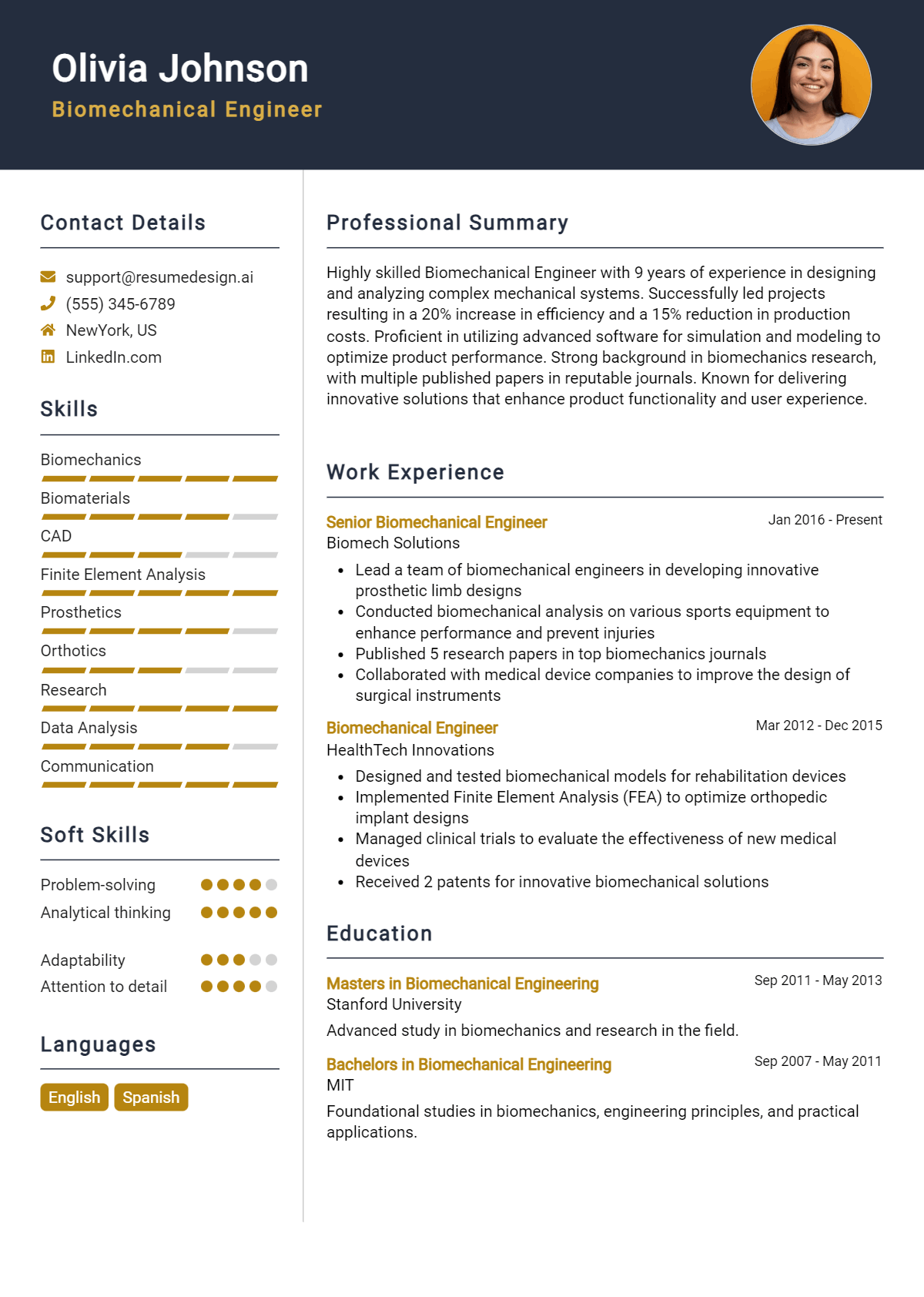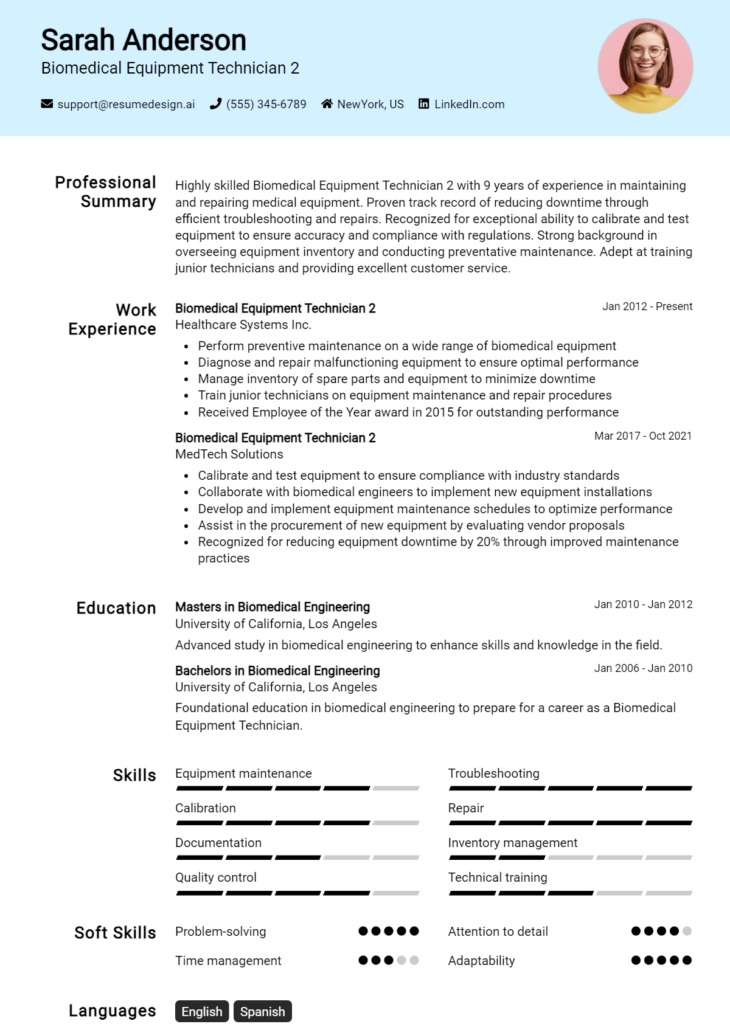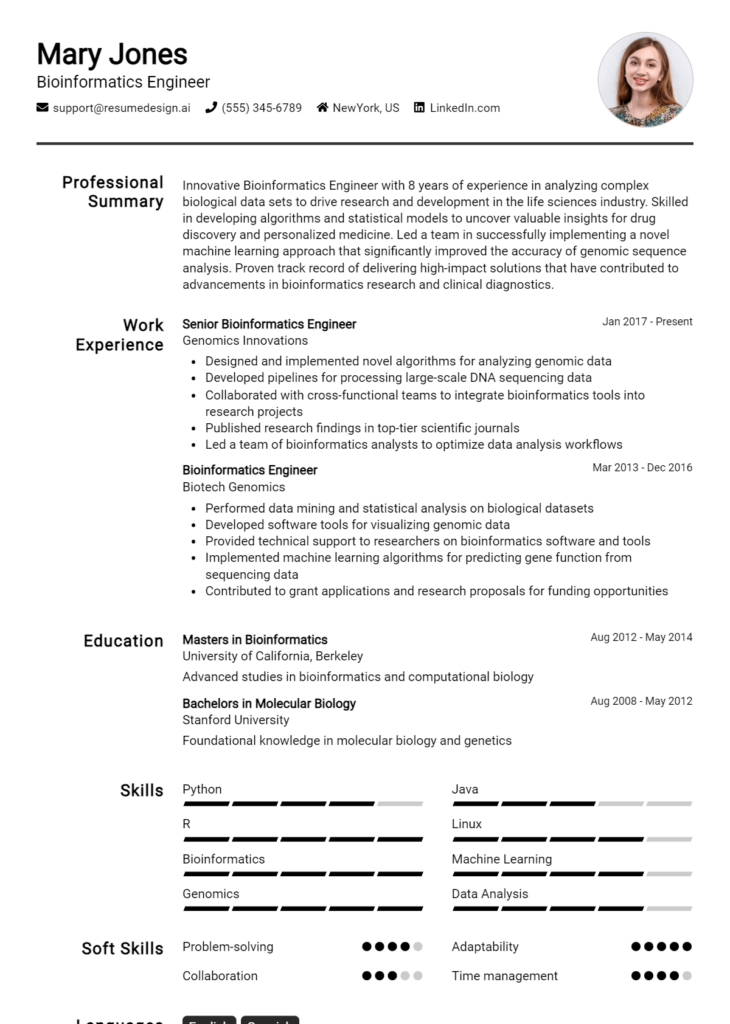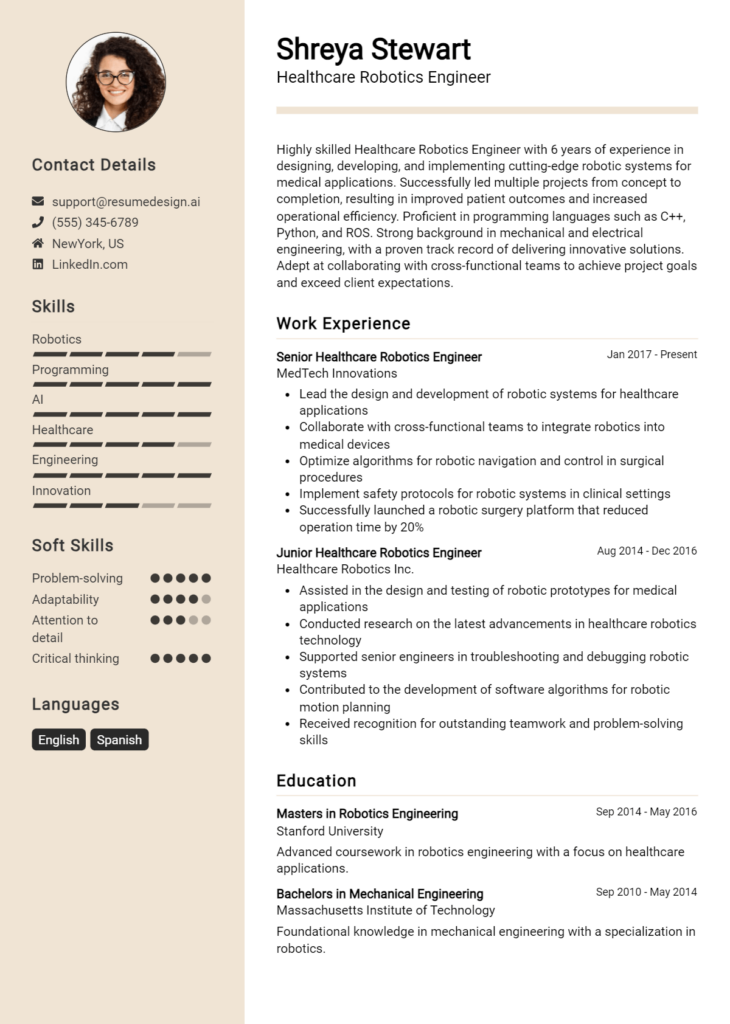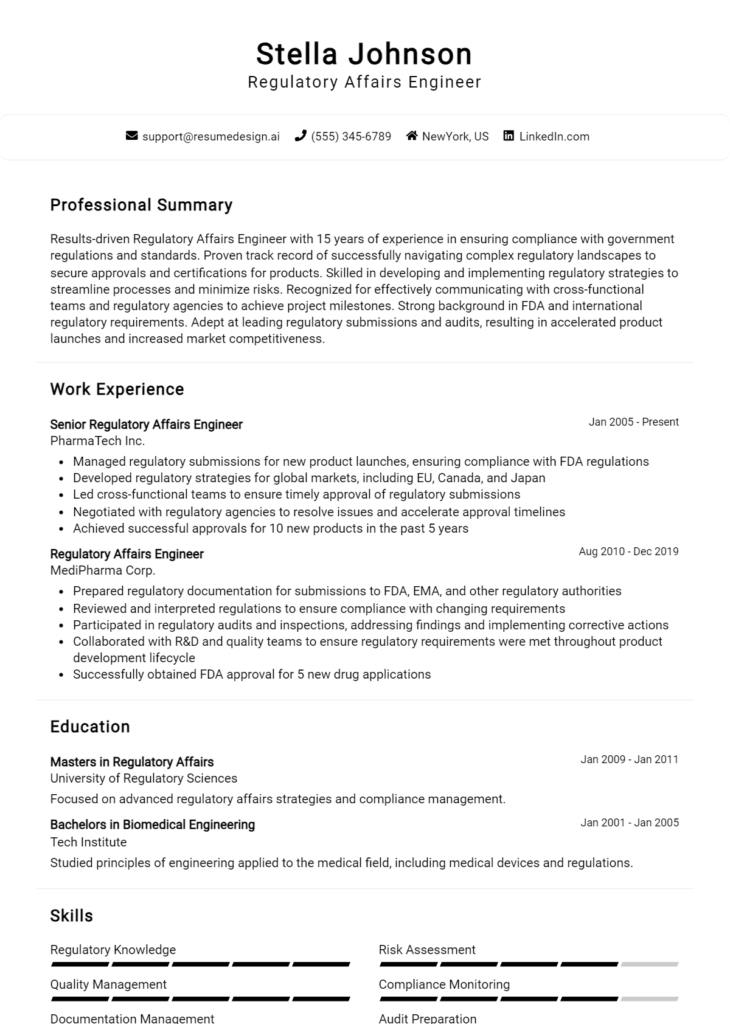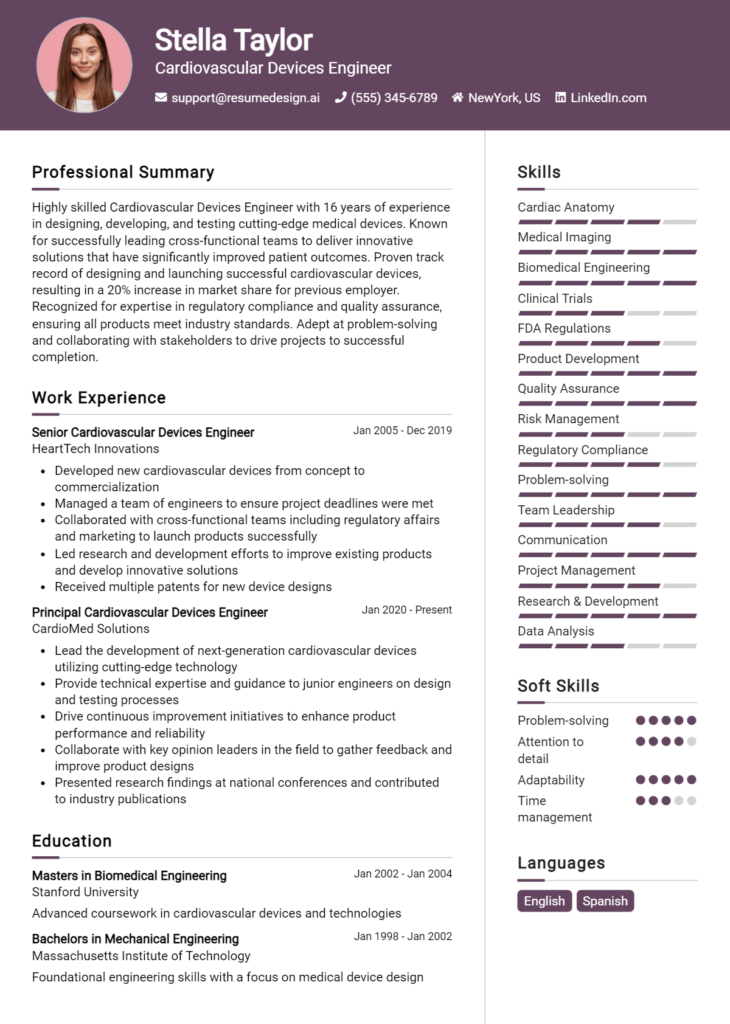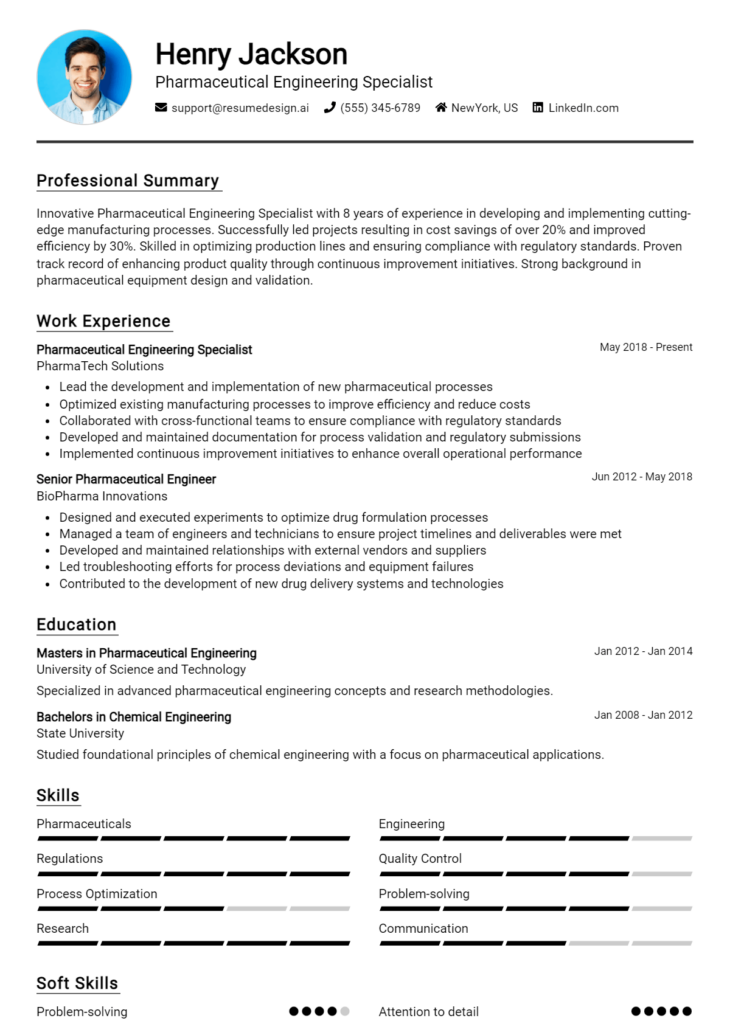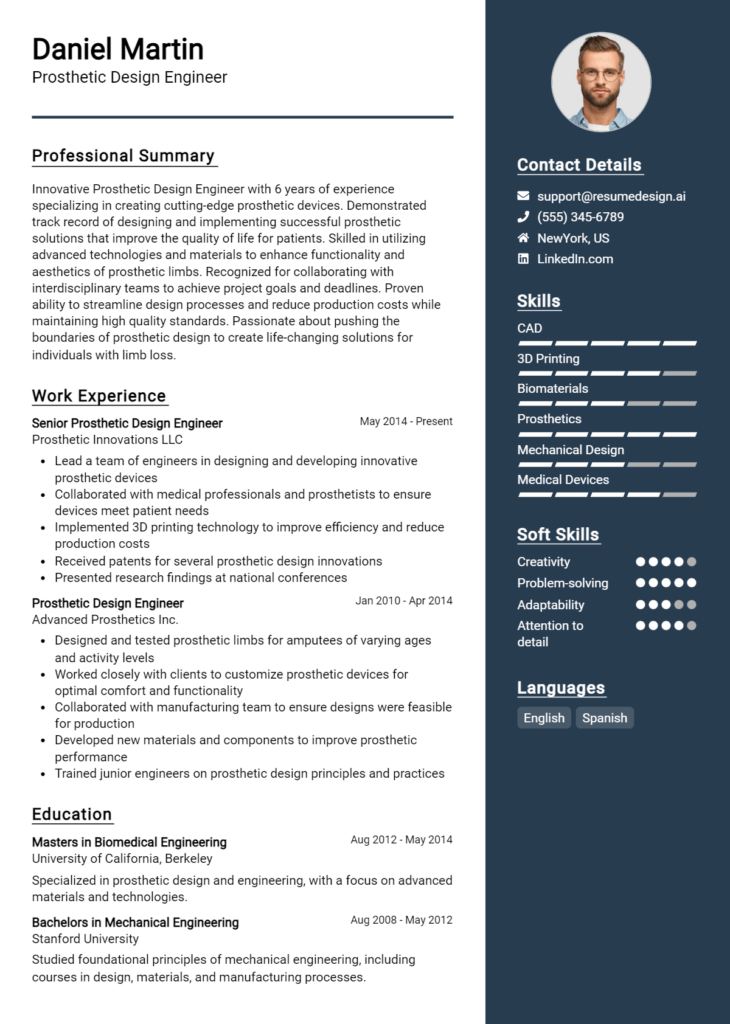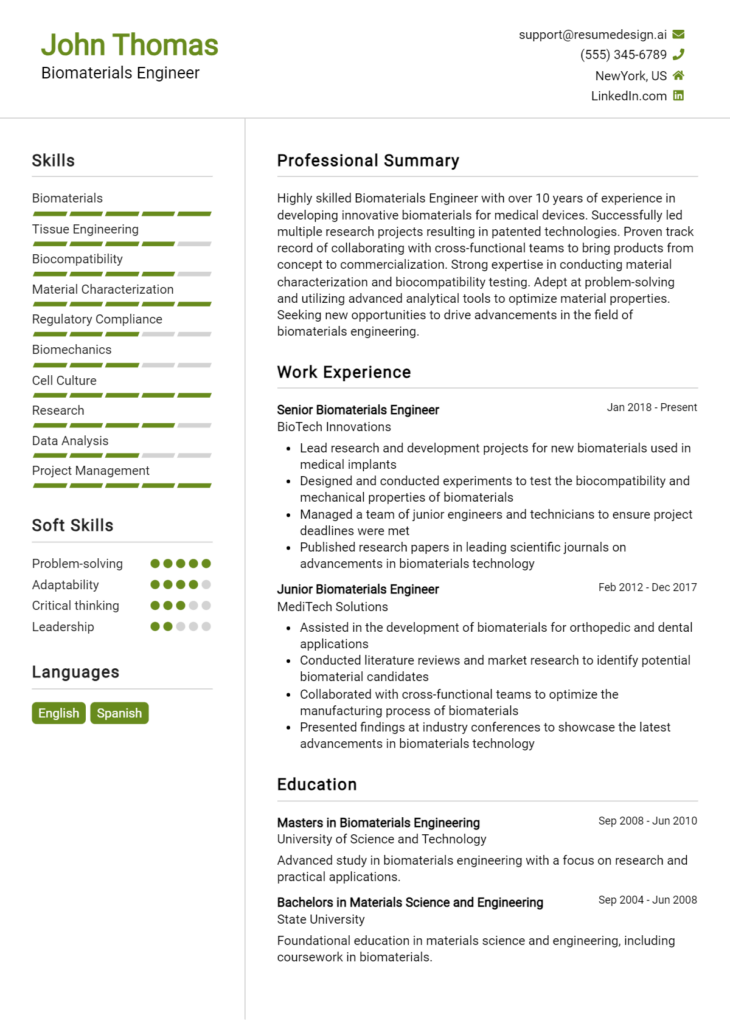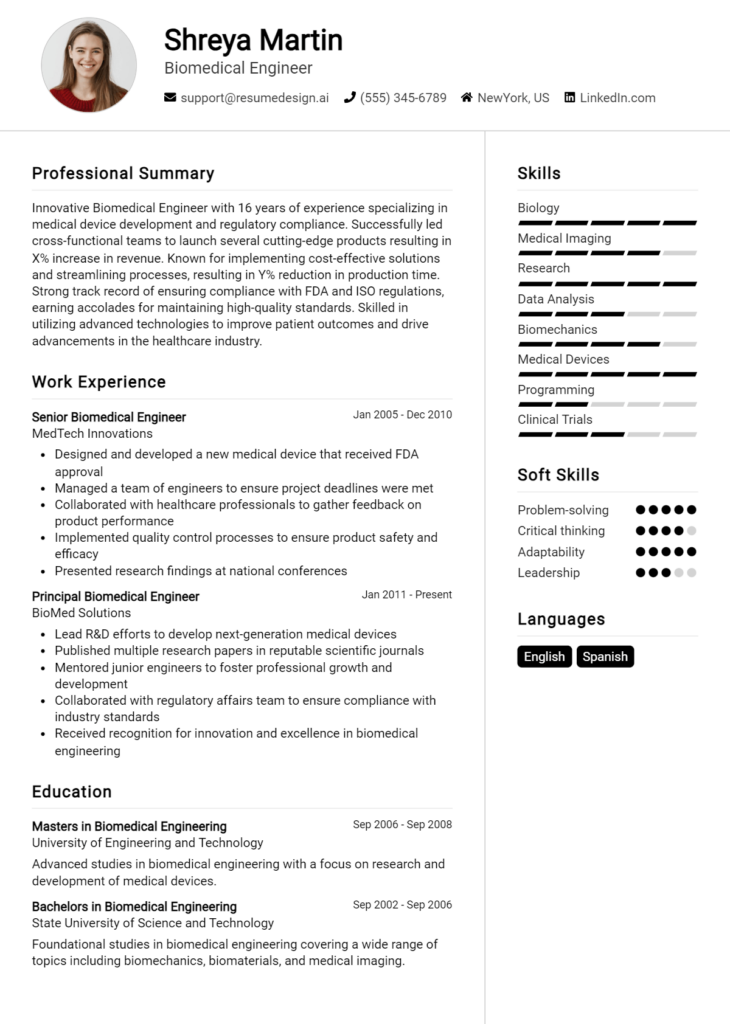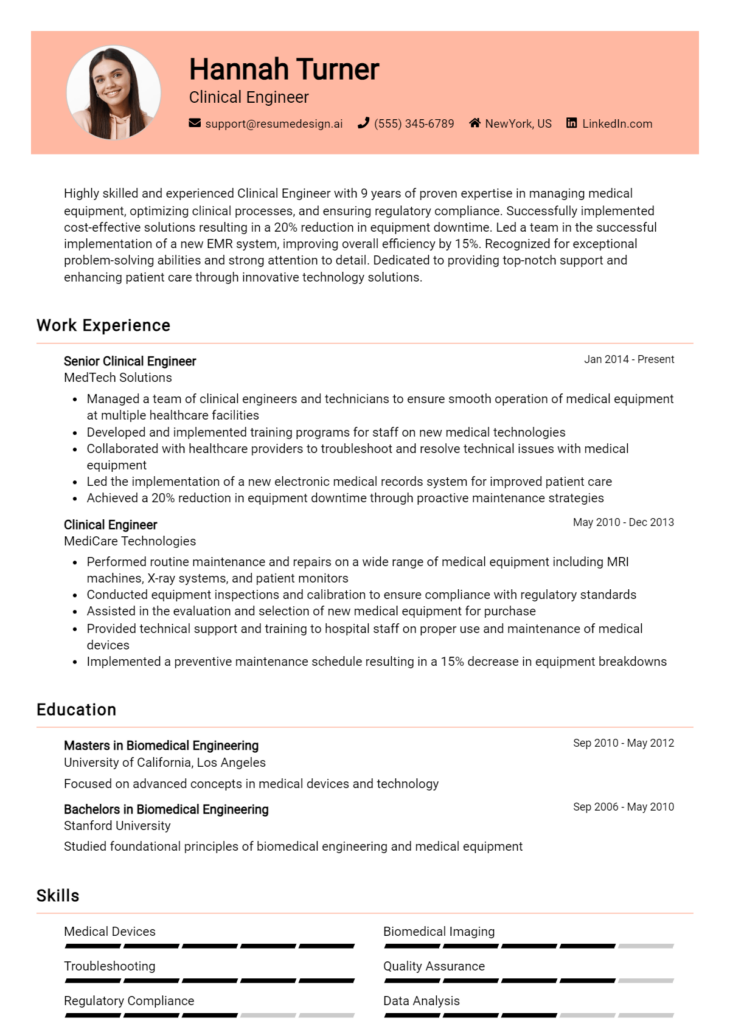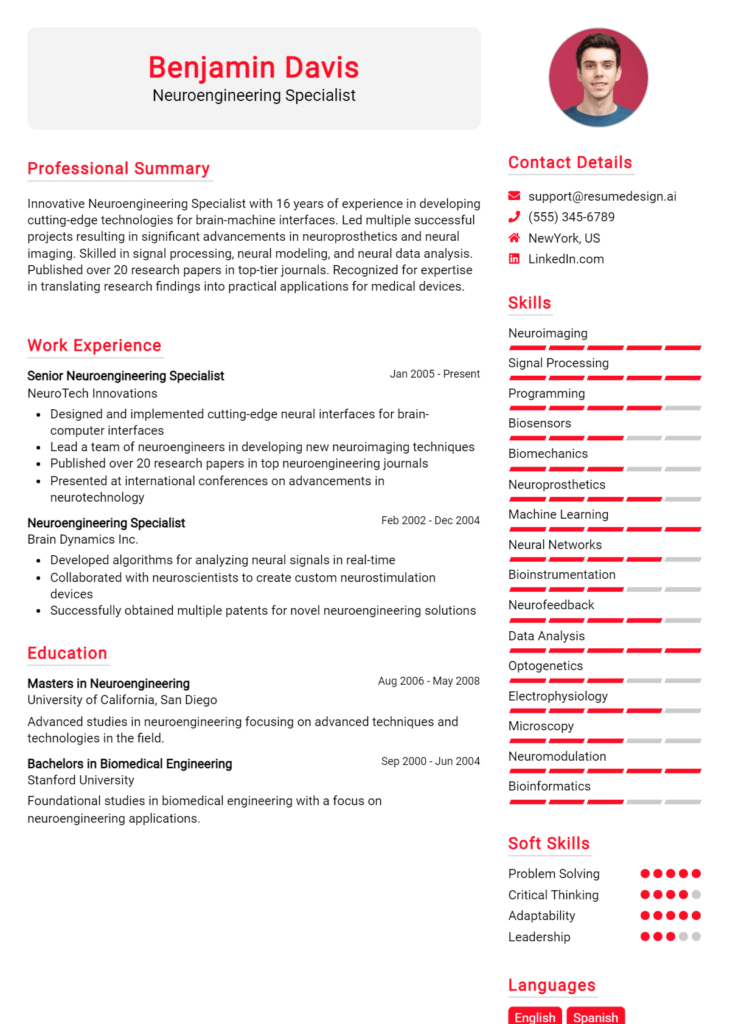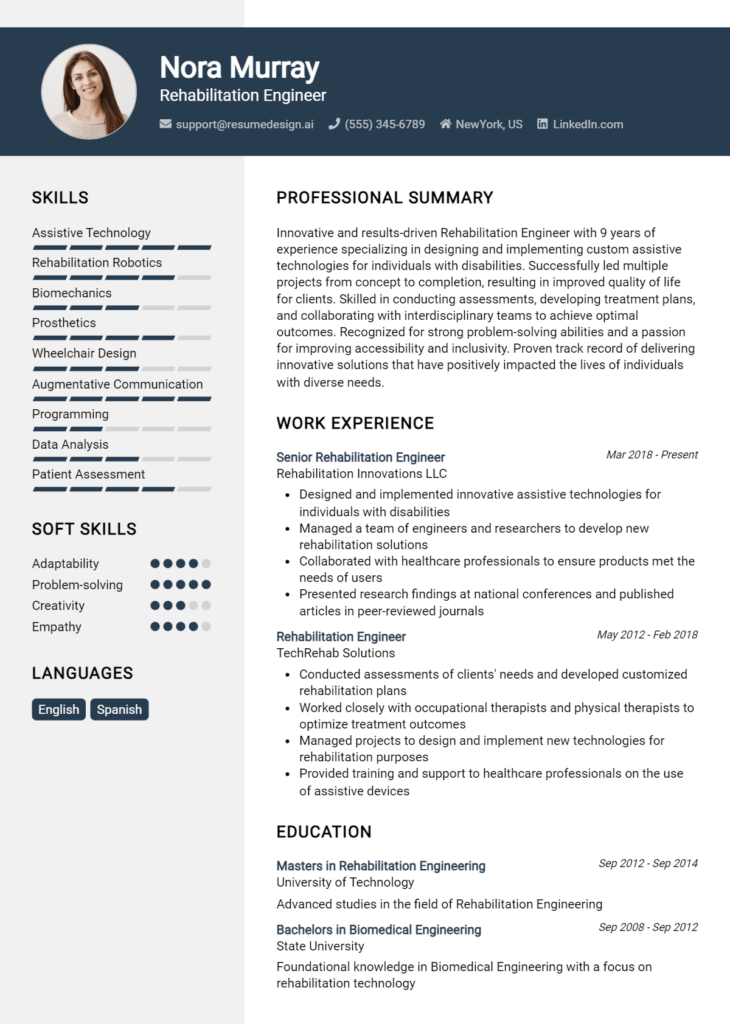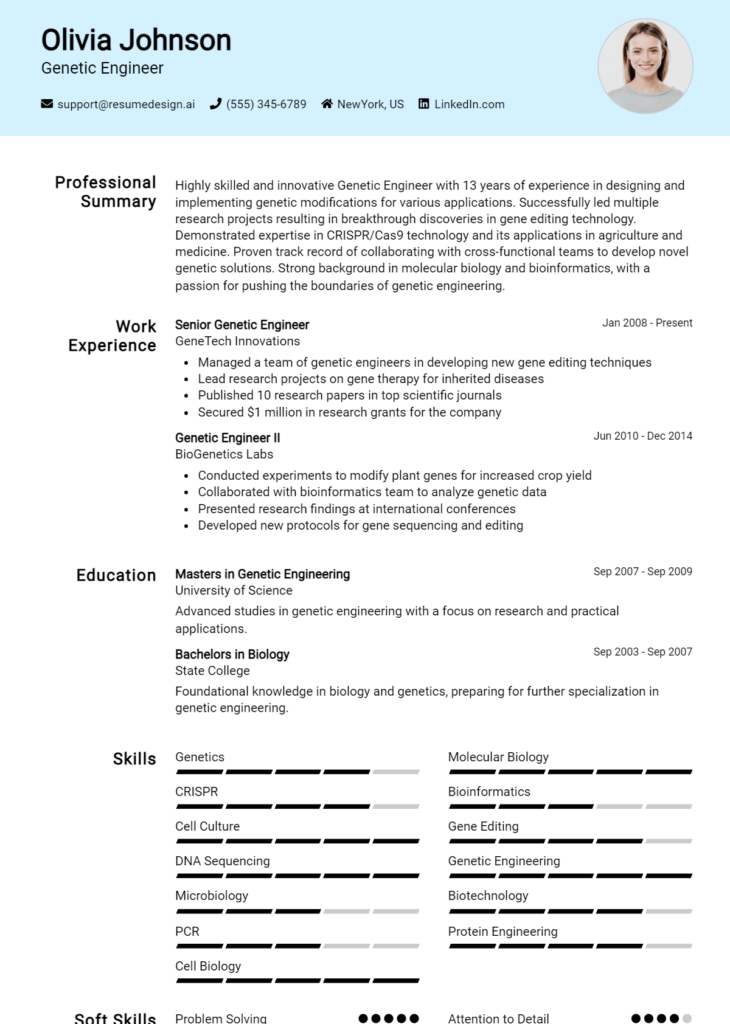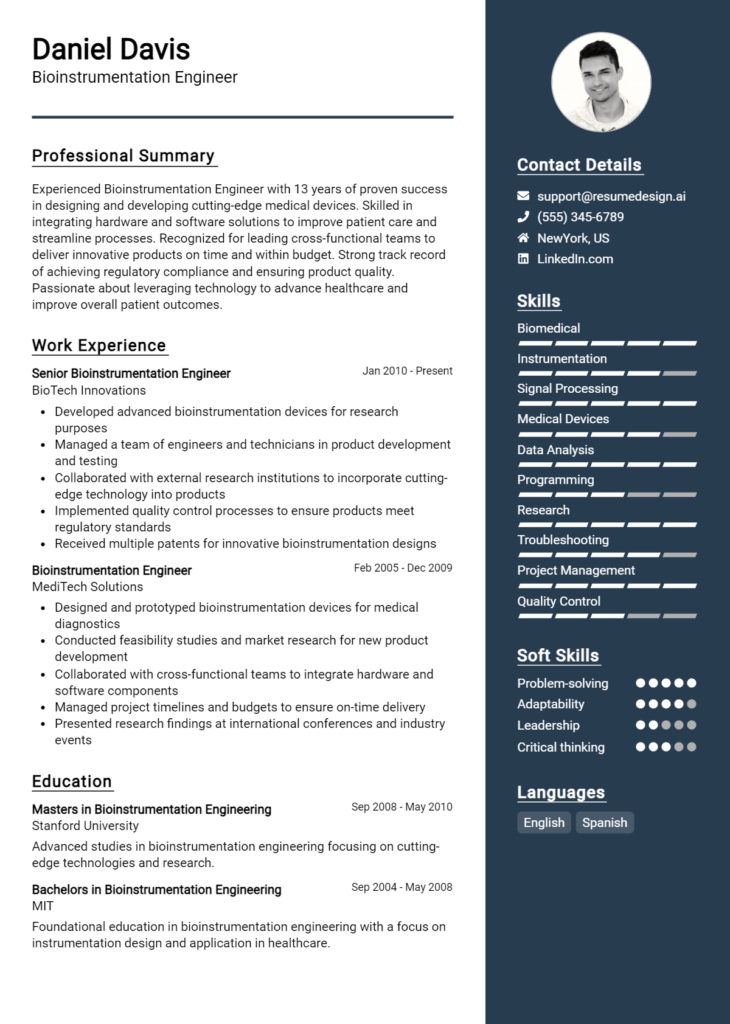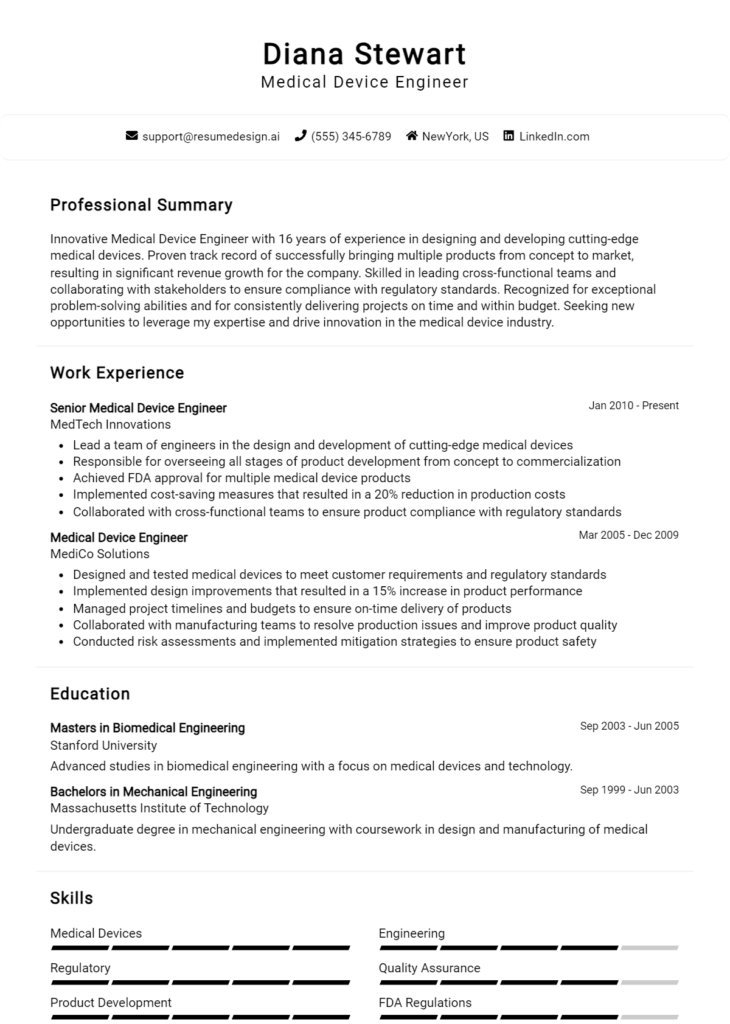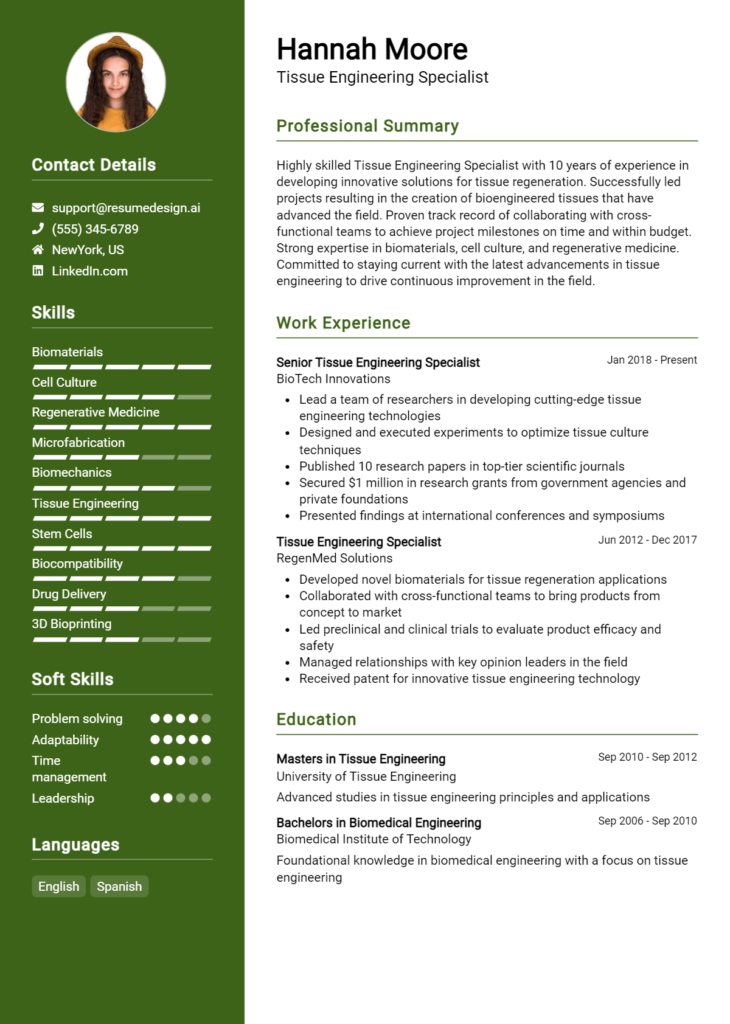Biomechanical Engineer Core Responsibilities
Biomechanical Engineers play a crucial role in designing and improving medical devices, prosthetics, and rehabilitation equipment. Their responsibilities include conducting research, analyzing biological systems, and collaborating with various departments like product development and clinical research. Essential skills include technical expertise in biomechanics, operational efficiency, and strong problem-solving abilities. These competencies are vital for achieving organizational goals, and a well-structured resume can effectively highlight these qualifications, making candidates stand out in a competitive field.
Common Responsibilities Listed on Biomechanical Engineer Resume
- Design and develop biomechanical devices and systems.
- Conduct experiments and analyze data to validate designs.
- Collaborate with multidisciplinary teams including physicians and engineers.
- Perform simulations and modeling of biological systems.
- Ensure compliance with industry regulations and standards.
- Develop prototypes and conduct testing for functionality.
- Provide technical support and training to clients and end-users.
- Document research findings and prepare technical reports.
- Evaluate the performance and safety of medical devices.
- Stay updated on the latest advancements in biomechanics.
High-Level Resume Tips for Biomechanical Engineer Professionals
In the competitive field of biomechanical engineering, a well-crafted resume is not just a document—it's your first and often only chance to make a lasting impression on potential employers. It serves as a vital marketing tool that needs to effectively showcase your specialized skills, relevant experiences, and professional achievements. A strong resume can set you apart from other candidates by clearly reflecting your expertise in designing, analyzing, and improving biomechanical systems. This guide aims to provide practical and actionable resume tips specifically tailored for professionals in the biomechanical engineering sector, ensuring you present your qualifications in the best possible light.
Top Resume Tips for Biomechanical Engineer Professionals
- Tailor your resume to match the specific job description, emphasizing the skills and experiences that align with the role.
- Showcase relevant experience by detailing projects or internships that highlight your engineering and analytical skills.
- Quantify your achievements with metrics, such as the percentage of efficiency improvements or cost savings achieved in projects.
- Highlight industry-specific skills, including proficiency with CAD software, finite element analysis, or knowledge of biomechanics principles.
- Use clear, concise language and avoid jargon that may not be familiar to all hiring managers.
- Incorporate keywords from the job listing to enhance your resume's visibility in Applicant Tracking Systems (ATS).
- Include a section on certifications or relevant coursework that demonstrates ongoing professional development in the field.
- Craft a compelling summary statement that succinctly captures your career goals and what you bring to the table as a biomechanical engineer.
- Keep your resume to one page if you have less than 10 years of experience, ensuring it is easy to read and focused.
- Proofread your resume carefully to eliminate any grammatical errors or typos that could detract from your professionalism.
By implementing these actionable tips, you can significantly enhance your resume's effectiveness, making it more likely to catch the attention of hiring managers in the biomechanical engineering field. A polished, tailored resume not only showcases your qualifications but also demonstrates your commitment to your career, ultimately increasing your chances of landing that coveted job.
Why Resume Headlines & Titles are Important for Biomechanical Engineer
In the competitive field of biomechanical engineering, a well-crafted resume headline or title serves as a critical first impression for job seekers. It not only grabs the attention of hiring managers but also succinctly summarizes the candidate’s key qualifications and strengths in a single impactful phrase. A compelling headline should be concise, relevant, and directly aligned with the job being applied for, giving hiring professionals a quick insight into the applicant’s suitability for the position. This can significantly enhance the chances of the resume being noticed amidst a myriad of applications.
Best Practices for Crafting Resume Headlines for Biomechanical Engineer
- Keep it concise: Aim for no more than 10-12 words.
- Be role-specific: Tailor your headline to the specific job title you are applying for.
- Highlight key skills: Incorporate vital skills that align with the job description.
- Use impactful language: Choose strong action verbs and adjectives to convey confidence.
- Avoid jargon: Ensure the language is clear and understandable to a broad audience.
- Reflect your experience level: Indicate your years of experience or level of expertise when applicable.
- Focus on achievements: If relevant, include quantifiable accomplishments or recognitions.
- Make it unique: Stand out from other candidates by showcasing what makes you different.
Example Resume Headlines for Biomechanical Engineer
Strong Resume Headlines
Innovative Biomechanical Engineer with 5+ Years in Medical Device Design
Results-Driven Biomechanical Engineer Specializing in Prosthetic Development
Dynamic Biomechanical Engineer with a Passion for Robotics and Biomechanics
Weak Resume Headlines
Engineer with Some Experience
Looking for Engineering Opportunities
The strong headlines are effective because they convey specific skills, experiences, and areas of expertise, immediately informing hiring managers of the candidate's qualifications. They use targeted language that resonates with the job description and showcases the applicant’s strengths. In contrast, the weak headlines fail to impress due to their vagueness and lack of relevance; they do not provide any substantial information that helps the candidate stand out, making it easy for hiring managers to overlook them in favor of more compelling options.
Writing an Exceptional Biomechanical Engineer Resume Summary
A resume summary is a critical component of a Biomechanical Engineer's application, serving as the first impression for hiring managers. A strong summary quickly captures attention by highlighting key skills, relevant experience, and notable accomplishments that align with the job requirements. It acts as a personalized introduction, allowing candidates to concisely convey their professional identity and demonstrate their value proposition. Crafting an impactful summary tailored to the specific job can significantly enhance a candidate's chances of standing out in a competitive field.
Best Practices for Writing a Biomechanical Engineer Resume Summary
- Quantify Achievements: Use numbers and metrics to showcase the impact of your work.
- Focus on Relevant Skills: Highlight technical and soft skills that are directly applicable to the job.
- Tailor to Job Description: Customize your summary to reflect the specific requirements and keywords from the job posting.
- Keep it Concise: Aim for 3-5 sentences that convey your qualifications without unnecessary fluff.
- Showcase Problem-Solving Abilities: Emphasize your capacity to address challenges and deliver innovative solutions.
- Include Industry Terminology: Use relevant jargon that reflects your expertise and familiarity with the field.
- Highlight Collaborative Experience: Mention teamwork and cross-disciplinary collaboration, which are vital in engineering roles.
- Demonstrate Continuous Learning: Reference any ongoing education or certifications to show commitment to professional growth.
Example Biomechanical Engineer Resume Summaries
Strong Resume Summaries
Results-driven Biomechanical Engineer with over 5 years of experience in developing innovative prosthetic solutions that improved user mobility by 30%. Proven expertise in CAD design and biomechanical testing, with a solid foundation in materials science.
Detail-oriented engineer specializing in the analysis of human motion and the design of orthopedic devices. Successfully led a team project that reduced production costs by 15% while enhancing product performance through rigorous testing and redesign.
Experienced Biomechanical Engineer with a passion for creating cutting-edge rehabilitation technologies. Achieved a 25% increase in patient satisfaction through the development of user-centered design protocols and effective multidisciplinary collaboration.
Dynamic engineer with a track record of implementing biomechanical research findings into practical applications. Secured two patents for innovative orthopedic devices and increased research funding by 40% through successful grant writing.
Weak Resume Summaries
Dedicated engineer with experience in the medical field and a desire to contribute to projects.
Motivated professional seeking to leverage skills in engineering and technology within the biomechanical sector.
The examples of strong resume summaries effectively highlight specific achievements, quantify results, and demonstrate direct relevance to the role of a Biomechanical Engineer. They provide clear evidence of the candidate's capabilities and contributions, making a compelling case for their candidacy. In contrast, the weak summaries lack detail, specificity, and measurable outcomes, making them less impactful and failing to capture the attention of hiring managers.
Work Experience Section for Biomechanical Engineer Resume
The work experience section of a Biomechanical Engineer resume is crucial as it serves as a testament to the candidate's technical skills, project management capabilities, and their ability to deliver high-quality products. This section not only showcases relevant experiences but also emphasizes the candidate's proficiency in applying engineering principles to solve complex problems in biomechanics. By quantifying achievements and aligning past work with industry standards, candidates can effectively demonstrate their value to potential employers. A well-crafted work experience section can set a candidate apart in a competitive job market, making it essential to highlight accomplishments and relevant skills.
Best Practices for Biomechanical Engineer Work Experience
- Use clear and concise language to describe your role and responsibilities.
- Quantify achievements with specific metrics, such as percentage improvements or project budgets.
- Highlight technical skills relevant to biomechanical engineering, such as CAD software proficiency or materials analysis.
- Emphasize collaboration by detailing teamwork experiences and cross-functional projects.
- Tailor your work experience to align with industry standards and job descriptions.
- Showcase leadership roles and initiatives that led to successful project outcomes.
- Include relevant certifications or training that support your practical experience.
- Focus on the impact of your contributions on both the organization and end-users.
Example Work Experiences for Biomechanical Engineer
Strong Experiences
- Led a team of 5 engineers in the design and testing of a new orthopedic implant, resulting in a 30% reduction in post-surgical complications.
- Developed a biomechanical model that improved the accuracy of stress analysis by 25%, directly influencing product design decisions.
- Collaborated with medical professionals to create a user-friendly prosthetic device, achieving a 95% satisfaction rate in user trials.
- Managed a project budget of $200,000 for a biomechanical research initiative, completing the project 10% under budget while exceeding performance targets.
Weak Experiences
- Worked on various engineering projects that involved biomechanics.
- Assisted in the design process of medical devices.
- Participated in team meetings related to engineering tasks.
- Involved in the testing of products without specific details.
The examples categorized as strong demonstrate clear, quantifiable outcomes, showcasing effective leadership and collaborative efforts that directly impact project success. These statements provide specific metrics and outcomes that align well with industry expectations. In contrast, the weak experiences lack detail and specificity, failing to convey the candidate's contributions or the significance of their roles. They do not highlight any measurable achievements or unique skills, making them less compelling to potential employers.
Education and Certifications Section for Biomechanical Engineer Resume
The education and certifications section of a Biomechanical Engineer resume is crucial in establishing the candidate's qualifications and expertise in the field. This section not only showcases the academic background of the applicant but also emphasizes any industry-relevant certifications and ongoing learning efforts. By including pertinent coursework, certifications, and specialized training, candidates can significantly enhance their credibility and demonstrate their alignment with the job role. This information is vital for employers who seek candidates with a solid educational foundation and a commitment to professional development in biomechanics and related disciplines.
Best Practices for Biomechanical Engineer Education and Certifications
- List degrees in reverse chronological order, starting with the most recent.
- Include relevant coursework that directly correlates with biomechanical engineering principles.
- Highlight certifications that are recognized in the industry, such as Professional Engineer (PE) or Certified Biomedical Equipment Technician (CBET).
- Provide details on specialized training programs or workshops attended to showcase continuous learning.
- Avoid including irrelevant degrees or certifications that do not pertain to the biomechanical engineering field.
- Clearly indicate the institution, degree type, and graduation date for each entry.
- Utilize bullet points for clarity and ease of reading, making it simple for employers to scan this section quickly.
- Consider including GPA if it is impressive (typically above 3.5) and relevant to the field.
Example Education and Certifications for Biomechanical Engineer
Strong Examples
- Bachelor of Science in Biomedical Engineering, University of California, Berkeley, Graduated May 2021
- Master of Science in Biomechanics, Stanford University, Expected Graduation May 2024
- Certified Biomedical Equipment Technician (CBET), 2022
- Relevant Coursework: Biomechanics of Human Movement, Medical Device Design, and Rehabilitation Engineering
Weak Examples
- Associate Degree in General Studies, Community College, Graduated May 2019
- Certification in Microsoft Office Suite, 2020
- High School Diploma, 2017
- Workshop on Time Management Skills, 2021
The examples provided demonstrate the distinction between strong and weak qualifications in the context of a Biomechanical Engineer resume. Strong examples showcase relevant degrees and certifications that align with the technical demands of the role, indicating a solid foundation in the field. In contrast, weak examples include irrelevant or outdated qualifications that do not contribute to the candidate’s expertise in biomechanics, potentially undermining their credibility in the eyes of employers.
Top Skills & Keywords for Biomechanical Engineer Resume
In the competitive field of biomechanical engineering, having a well-crafted resume that highlights relevant skills is essential for standing out to potential employers. Skills not only demonstrate your technical capabilities and expertise but also reflect your ability to adapt and collaborate in various work environments. A strong combination of hard and soft skills can effectively showcase your qualifications and make your resume more attractive. As you prepare your resume, it’s crucial to emphasize these skills to align with the specific requirements of the job you’re applying for. For further insights into how you can enhance your resume, visit our skills page and explore the importance of work experience as well.
Top Hard & Soft Skills for Biomechanical Engineer
Soft Skills
- Problem-solving
- Critical thinking
- Communication
- Teamwork and collaboration
- Adaptability
- Attention to detail
- Time management
- Creativity
- Leadership
- Interpersonal skills
- Conflict resolution
- Ethical judgment
- Empathy
Hard Skills
- Proficiency in CAD software (e.g., SolidWorks, AutoCAD)
- Knowledge of biomechanics principles
- Experience with finite element analysis (FEA)
- Programming skills (e.g., MATLAB, Python)
- Understanding of materials science
- Data analysis and statistical methods
- Medical device design and testing
- Knowledge of regulatory standards (e.g., FDA, ISO)
- Laboratory techniques and instrumentation
- 3D modeling and simulation
- Biomechanical testing methods
- Project management
- Research methodologies
- Prototyping and manufacturing processes
Stand Out with a Winning Biomechanical Engineer Cover Letter
Dear [Hiring Manager's Name],
I am excited to apply for the Biomechanical Engineer position at [Company Name], as advertised on [where you found the job listing]. With a Master’s degree in Biomedical Engineering and over [X years] of hands-on experience in biomechanical analysis and product development, I am eager to contribute my expertise and passion for innovative engineering solutions to your dynamic team. My background in both research and practical applications has equipped me with a strong skill set that aligns well with the requirements of this role.
In my previous role at [Previous Company Name], I successfully led a project focused on the development of a new orthopedic device aimed at enhancing patient outcomes. My responsibilities included conducting extensive biomechanical analyses, utilizing software such as ANSYS and SolidWorks to simulate real-world scenarios, and collaborating closely with cross-functional teams to ensure compliance with regulatory standards. This experience not only honed my technical skills but also reinforced my ability to communicate complex concepts effectively to both technical and non-technical stakeholders.
I am particularly drawn to [Company Name] because of your commitment to pioneering advancements in medical technology and your focus on improving patient care. I am excited about the opportunity to work on projects that align with my values and expertise. I am confident that my analytical mindset, combined with my passion for biomechanics, will allow me to contribute meaningfully to your team and help drive innovative solutions that improve lives.
Thank you for considering my application. I look forward to the opportunity to discuss how my background, skills, and enthusiasms align with the innovative work being done at [Company Name]. I am eager to bring my knowledge of biomechanical engineering to your team and contribute to projects that make a difference in the field.
Sincerely,
[Your Name]
[Your Contact Information]
[LinkedIn Profile or Other Relevant Links]
Common Mistakes to Avoid in a Biomechanical Engineer Resume
When crafting a resume for a Biomechanical Engineer position, it's essential to present your qualifications and experiences effectively. However, many candidates make common mistakes that can hinder their chances of landing an interview. Understanding these pitfalls can help you create a more compelling resume that catches the attention of hiring managers. Here are some common mistakes to avoid:
Lack of Tailoring: Failing to customize your resume for each job application can make it seem generic. Tailor your skills and experiences to align with the specific requirements of the job you’re applying for.
Excessive Technical Jargon: While technical expertise is crucial, using too much specialized terminology can alienate non-technical hiring managers. Aim for a balance that showcases your knowledge without overwhelming the reader.
Ignoring Soft Skills: Biomechanical engineering isn’t just about technical skills; communication and teamwork are vital. Neglecting to highlight these soft skills can leave a gap in your resume.
Overloading with Irrelevant Experience: Including every job you’ve held can clutter your resume. Focus on relevant experience that demonstrates your qualifications for the specific role you’re seeking.
Neglecting Achievements: Simply listing responsibilities doesn’t convey the value you brought to past positions. Use quantifiable achievements to illustrate your impact in previous roles.
Poor Formatting: A cluttered or unprofessional layout can distract from your qualifications. Use clear headings, consistent font sizes, and bullet points to enhance readability.
Grammatical Errors and Typos: Spelling mistakes and grammatical errors can create a negative impression. Proofread your resume multiple times, and consider having someone else review it as well.
Inadequate Contact Information: Omitting or incorrectly formatting your contact information can lead to missed opportunities. Ensure your email, phone number, and LinkedIn profile (if applicable) are accurate and easy to find.
Conclusion
As we conclude our exploration of the Biomechanical Engineer role, it's essential to highlight the significance of crafting a strong resume that reflects your unique skills and experiences in this dynamic field. We've discussed the critical skills needed, such as proficiency in biomechanics, knowledge of materials science, and experience with engineering design. Additionally, we touched upon the importance of showcasing your ability to work collaboratively within interdisciplinary teams and your commitment to innovative problem-solving.
To ensure your resume stands out in a competitive job market, we encourage you to take advantage of the available resources. Consider using resume templates to guide your formatting and layout, or try the resume builder for a more interactive approach to creating your document. If you're looking for inspiration, explore resume examples that can help you highlight your achievements effectively. Don’t forget the value of a well-crafted cover letter; you can find cover letter templates to help you make a strong first impression.
Now is the time to review and refine your Biomechanical Engineer resume to ensure it accurately represents your qualifications and aspirations. Take action today and utilize these valuable tools to elevate your job application and land your dream role in the field of biomechanics!

